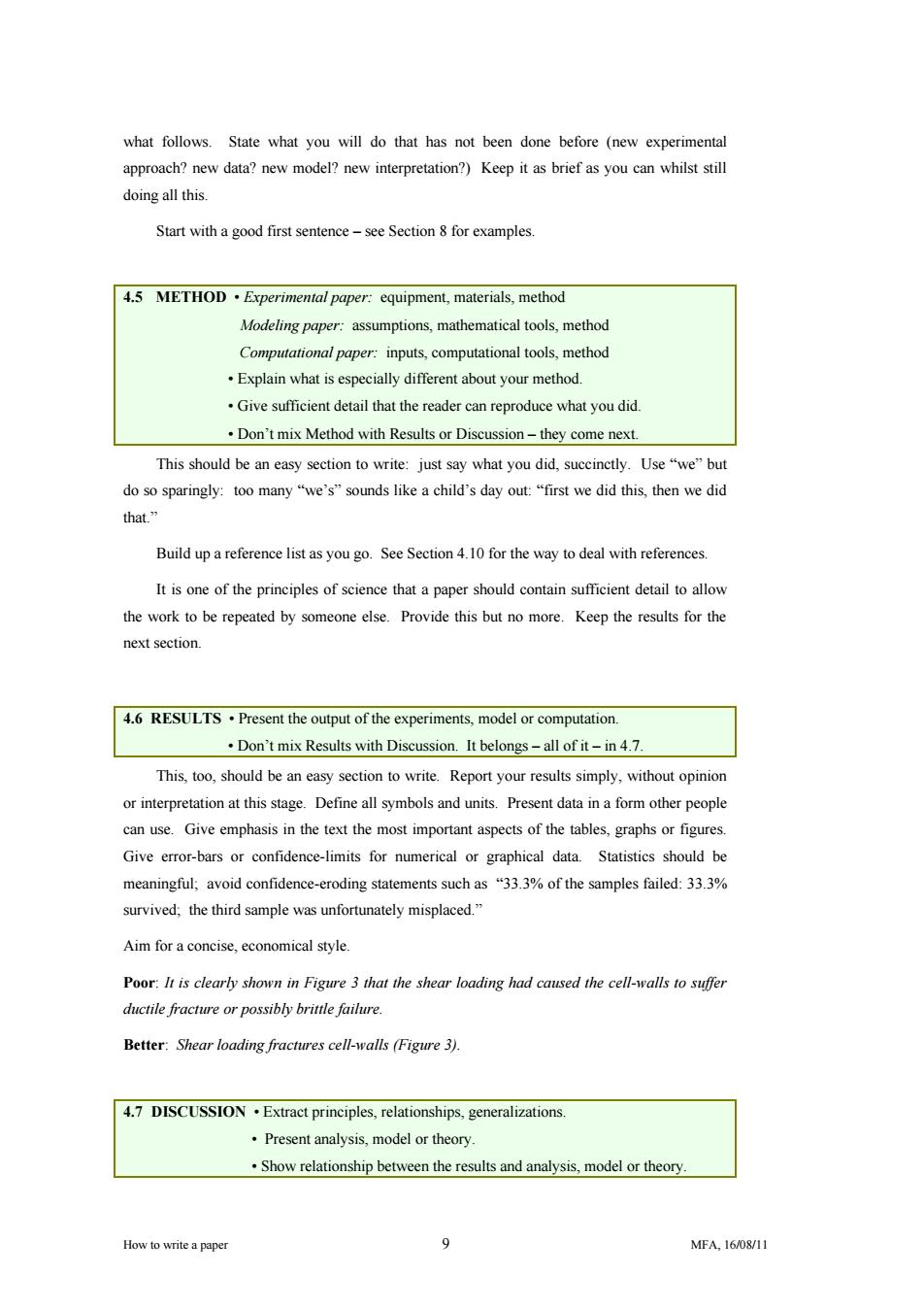正在加载图片...

what follows.State what you will do that has not been done before (new experimental approach?new data?new model?new interpretation?)Keep it as brief as you can whilst still doing all this. Start with a good first sentence-see Section 8 for examples. 4.5 METHOD Experimental paper:equipment,materials,method Modeling paper:assumptions,mathematical tools,method Computational paper:inputs,computational tools,method Explain what is especially different about your method. Give sufficient detail that the reader can reproduce what you did. Don't mix Method with Results or Discussion-they come next. This should be an easy section to write:just say what you did,succinctly.Use "we"but do so sparingly:too many "we's"sounds like a child's day out:"first we did this,then we did that.” Build up a reference list as you go.See Section 4.10 for the way to deal with references. It is one of the principles of science that a paper should contain sufficient detail to allow the work to be repeated by someone else.Provide this but no more.Keep the results for the next section. 4.6 RESULTS.Present the output of the experiments,model or computation. .Don't mix Results with Discussion.It belongs-all of it-in 4.7. This,too,should be an easy section to write.Report your results simply,without opinion or interpretation at this stage.Define all symbols and units.Present data in a form other people can use.Give emphasis in the text the most important aspects of the tables,graphs or figures. Give error-bars or confidence-limits for numerical or graphical data.Statistics should be meaningful:avoid confidence-eroding statements such as "33.3%of the samples failed:33.3% survived;the third sample was unfortunately misplaced." Aim for a concise,economical style. Poor:It is clearly shown in Figure 3 that the shear loading had caused the cell-walls to suffer ductile fracture or possibly brittle failure. Better:Shear loading fractures cell-walls (Figure 3). 4.7 DISCUSSION.Extract principles,relationships,generalizations. Present analysis,model or theory. Show relationship between the results and analysis,model or theory How to write a paper 9 MFA,16/08/11How to write a paper 9 MFA, 16/08/11 what follows. State what you will do that has not been done before (new experimental approach? new data? new model? new interpretation?) Keep it as brief as you can whilst still doing all this. Start with a good first sentence – see Section 8 for examples. 4.5 METHOD • Experimental paper: equipment, materials, method Modeling paper: assumptions, mathematical tools, method Computational paper: inputs, computational tools, method • Explain what is especially different about your method. • Give sufficient detail that the reader can reproduce what you did. • Don’t mix Method with Results or Discussion – they come next. This should be an easy section to write: just say what you did, succinctly. Use “we” but do so sparingly: too many “we’s” sounds like a child’s day out: “first we did this, then we did that.” Build up a reference list as you go. See Section 4.10 for the way to deal with references. It is one of the principles of science that a paper should contain sufficient detail to allow the work to be repeated by someone else. Provide this but no more. Keep the results for the next section. 4.6 RESULTS • Present the output of the experiments, model or computation. • Don’t mix Results with Discussion. It belongs – all of it – in 4.7. This, too, should be an easy section to write. Report your results simply, without opinion or interpretation at this stage. Define all symbols and units. Present data in a form other people can use. Give emphasis in the text the most important aspects of the tables, graphs or figures. Give error-bars or confidence-limits for numerical or graphical data. Statistics should be meaningful; avoid confidence-eroding statements such as “33.3% of the samples failed: 33.3% survived; the third sample was unfortunately misplaced.” Aim for a concise, economical style. Poor: It is clearly shown in Figure 3 that the shear loading had caused the cell-walls to suffer ductile fracture or possibly brittle failure. Better: Shear loading fractures cell-walls (Figure 3). 4.7 DISCUSSION • Extract principles, relationships, generalizations. • Present analysis, model or theory. • Show relationship between the results and analysis, model or theory